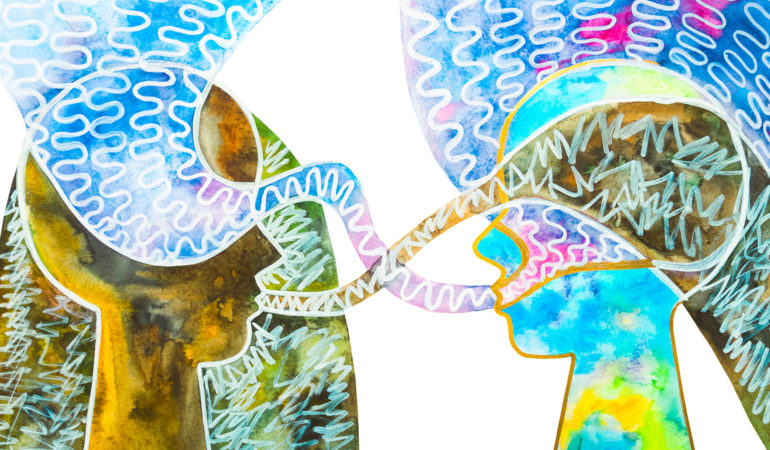At the start of the pandemic, I was a new mom—just returning from maternity leave. As most other university instructors at that time, I was tasked with transferring my courses to an online format immediately upon my return. One of the classes that I taught was a course on Systemic Child and Adolescent Treatment. I can’t be fully certain of the role that sleep deprivation played, but I couldn’t wrap my mind around how I was going to lead an engaging online course that relied so heavily on systemic experiential therapeutic activities, many of which required the use of physical resources that were tucked away in my office in their own sort of Toy Story: Locked in Quarantine.
I liked to imagine puppets doing shows for passersby from my downtown Seattle second story office window. Toy figurines, using the family mobile gifted to me by a former student, propel their descent from the bookshelf adjacent to Whitaker’s (1989) Midnight Musings of a Family Therapist, and have movie nights on the “big screen” of my computer, starring Minuchin, Satir, and other famed family therapists that these toys have heard so much about, but haven’t seen, since the DVDs are disappointingly always viewed in courses that they’ve never been invited to attend. Okay, that last part might have been the sleep deprivation. I digress.
Luckily, sleepless nights provided ample time to think, and I came up with what I thought were some pretty creative ideas. Starting with paper bag family puppet interviews and clip art play genograms (Cobb, Maricielo, Moran, & Quintinita, 2020), I eventually transferred every activity that I traditionally conducted to a format compatible with an online platform. To ensure that students had materials they needed to participate, I sent care packages with materials that allowed them to engage in roleplays that were normally conducted in person, at least in some altered form. On the first day of class, students excitedly opened a USPS priority mail envelop stuffed with construction paper, small paper bags, coloring pages, handmade variations of The Ungame (a board game created by Rhea Zakich in 1972), cards, printed clip art, googly eyes in assorted sizes, colorful yarn, pipe cleaners, glue sticks, and crayons, including an eight-pack of Crayola’s Multicultural Crayons that brought tears to more than one participant who could never find the right color to match their skin tone as a child.
What I’ve learned over the last two years from working with students and collaborating with other therapists is that my story isn’t unique. At the start of the pandemic, professionals across the globe quickly figured out how to transfer in-person to online practices (e.g., Crockett, Becraft, Phillips, Wakeman, & Cataldo 2020; Sammons, VandenBos, & Martin 2020). Beyond logistics faced by other counselors and psychotherapists, marriage and family therapists (MFTs) reimagined the application of systems theory, figuring out how to actively engage individuals, intimate partnerships, families, groups, and supervision teams via online platforms (e.g., Allan, Wiebe, Johnson, Piaseckyj, & Campbell, 2021; Levy, Mason, Russon, & Diamond 2021; Taylor, Springer, Bischoff, & Smith, 2021). And though there may have been difficulty in applying systemic work in ways that we did in the past, with creative thinking, teletherapy allows for the application of systems theory in new and unique ways.
From this experience, I had the idea to edit books on The Therapist’s Notebook for Systemic Teletherapy: Creative Interventions for Effective Online Therapy (in progress) and The Therapist’s Notebook for Teletherapy with Children and Adolescents: Creative Interventions for Effective Online Therapy (in progress). Inspired by interventions in these upcoming books, in the sections that follow, I’ve organized a few creative teletherapy ideas according to foundational family systems theories. My hope is to highlight not only the possibilities of systemic work via teletherapy, but also the application of the grounding theories that are integral to the work we do as MFTs.
Transgenerational systems theories
Perhaps most obvious, teletherapy allows us to connect with clients that we might not otherwise be able to reach (e.g., Reed, Messler, Coombs, & Quevillon, 2014). For those in rural communities where access to care has traditionally been a challenge, the rapid progression of teletherapy exponentially increased options available for treatment. This now means that anywhere internet access and technology are available, MFTs can do their work!
At the same time, advances in teletherapy have allowed MFTs to bring even more people “into the room.” In the past, when a member of the client system couldn’t physically be present, MFTs could apply systemic thinking to support healing and growth without all key parties being in the actual therapy room. Yet, it can be so much more impactful to include them directly in treatment, especially when working on balancing ledgers and increasing differentiation.
Structural theory
It’s true; online therapy also sets limits on interventions that we might want to conduct. These limitations are in essence boundaries. Yet, as structural theorists are aware, boundaries aren’t necessarily a bad thing (Minuchin, 1974). Why not use them to our advantage? For instance, how many times have you played a game with someone who insisted on bending the rules? Games played via online formats, however, don’t usually allow for this flexibility. Online games typically set clear rules and hold you to them. Therefore, games played during teletherapy create unique opportunities to discuss boundaries and rules, and to also process the frustrations that can occur when we can’t change them.
Strategic theory
Alternatively, the limitations of teletherapy surrounding games housed within the therapist’s physical location allow MFTs to be more strategic in their approach. For example, in working with a client who is used to getting their way, the therapist might “stack the deck” so that the therapist or other family members are bound to win. When playing discussion-based games like the Ungame, the therapist might preselect cards that they think would be of particular benefit to discuss. Therapists might also insert their own questions into the deck that are of relevance to presenting problems. In both examples, the therapist ensures that existing patterns within the client system are interrupted (Watzlawick, Weakland, & Fisch, 1974) and allows opportunities to process this difference within a therapeutic setting.
Experiential therapy
Having clients participate in therapy from their own homes also comes with unique benefits (Markowitz et al., 2020). For example, MFTs might ask clients for a tour of their living space, which might provide unique insights for the therapist regarding the client system. Therapists might also seek opportunities to encourage new interactions between clients and their environment. Clients struggling with hoarding disorder, for instance, could be supported by their therapist as they sort, donate, recycle, or throw away objects in their home. Clients with eating disorders could have their therapist’s support as they navigate the food in their home, as they eat, and after they eat. Or clients simply feeling stuck or sedentary might be encouraged to sit in a space that they don’t normally inhabit.
Solution-focused brief therapy
Building on a home-based experiential approach, solution-focused (attributed to de Shazer and Berg in 1982) therapists might ask clients to actually show them how they solve problems within their living environment. Where do they get their best thinking done? Where have they successfully discussed difficult topics in the past? What did that look like? Another example of this might be a solution-focused scavenger hunt where younger clients are instructed to find and share objects within the household that help them to solve a variety of different problems. Through this playful solution-focused approach, a conversation might be had about internal resources that help to solve presenting problems.
Narrative family therapy
Likewise, homes contain stories and narratives that can be witnessed with the use objects, photos, and places that clients might not otherwise have the opportunity to share in office-based therapy settings. A therapist might ask a grieving family to share keepsakes or photographs of a deceased loved one and to share the stories that emerge as they interact with these objects. Subjugated narratives and alternative stories might emerge with deconstruction and unpacking of these stories (White & Epston, 1990), especially as members of the client system witness both unique and shared perspectives.
Milan family therapy
And finally, online supervision has allowed for the reinvention of reflecting teams, traditional to the Milan approach. Whereas reflecting teams have historically relied on one-way mirrors and therapy occurring simultaneously with live supervision groups (Boscolo, Cecchin, Hoffman, & Penn, 1987), virtual supervision now allows reflecting teams as an accessible form of therapeutic intervention easily conducted without the availability of onsite clinics or therapy observation rooms (Cobb et al., 2021).
There are many other examples of ways in which teletherapy can be used to the advantage of family systems theories; these are just a few. I hope that they inspire you in your own creative application of systemic theories to teletherapy practice and look forward to the continued development of this important topic for MFTs.
Building on a home-based experiential approach, solution-focused therapists might ask clients to actually show them how they solve problems within their living environment.

Rebecca (Becky) Cobb, PhD, LMFT, is an AAMFT Professional member holding the Clinical Fellow and Approved Supervisor designations, and an assistant clinical professor and clinical coordinator for Seattle University’s Couples and Family Therapy program. She is the editor of The Therapist’s Notebook for Systemic Teletherapy: Creative Interventions for Effective Online Therapy (Routledge, due to be published in 2024) and The Therapist’s Notebook for Teletherapy with Children and Adolescents: Creative Interventions for Effective Online Therapy (Routledge, due to be published in 2025). Cobb maintains a private practice in Seattle, WA.
REFERENCES
Allan, R., Wiebe, S. A., Johnson, S. M., Piaseckyj, O., & Campbell, T. L. (2021). Practicing emotionally focused therapy online: Calling all relationships. Journal of Marital and Family Therapy, 47, 424-439.
Boscolo, L., Cecchin, G., Hoffman, L., & Penn, P. (1987). Milan systemic family therapy: Conversations in therapy & practice. New York: Basic Books.
Cobb, R. A. (Ed.). (in progress). The therapist’s notebook for systemic teletherapy: Creative interventions for effective online therapy. Oxfordshire, England, UK: Routledge.
Cobb, R. A. (Ed.). (in progress). The therapist’s notebook for teletherapy with children and adolescents: Creative interventions for effective online therapy. Oxfordshire, England, UK: Routledge.
Cobb, R. A., Brownell, S., Camera, S., Chapin, C., Eppler, C., & Rogge, M. (2021). The virtual reflecting team: A Milan approach to systemic teletherapy intervention. Paper presented at the annual meeting of the Washington Association for Marriage and Family Therapy, Seattle, WA.
Cobb, R. A., Maricielo, S., Moran, S., & Quintinita, M. (2020, September). Creative teletherapy interventions with youth and families. Paper presented at the annual meeting of the Washington Association for Marriage and Family Therapy, Seattle, WA.
Crockett, J. L., Becraft, J. L., Phillips, S. T., Wakeman, M., & Cataldo, M. F. (2020). Rapid conversion from clinical to telehealth behavioral services during the COVID-19 pandemic. Behavior Analysis in Practice, 13, 725-735.
Levy, S., Mason, S., Russon, J., & Diamond, G. (2021). Attachment-based family therapy in the age of telehealth and COVID-19. Journal of Marital and Family Therapy, 47, 440-454.
Markowitz, J. C., Milrod, B., Heckman, T. G., Bergman, M., Amsalem, D., Zalman, H., Ballas, T., & Neria, Y. (2020). Psychotherapy at a distance, The American Journal of Psychiatry, 178, 240-246.
Minuchin, S. (1974). Families and family therapy. Cambridge, MA: Harvard University Press.
Reed, R. N., Messler, E. C., Coombs, T. E., & Quevillon, R. P. (2014). Social media use and the acceptability of telepsychological services in rural populations. Journal of Rural Mental Health, 38, 2-8.
Sammons, M. T., VandenBos, G. R., & Martin, J. N. (2020). Psychological practice and the COVID-19 crisis: A rapid response survey. Journal of Health Service Psychology, 46, 51-57.
Taylor, N. C., Springer, P. R., Bischoff, R. J., & Smith, J. P. (2021). Experiential family therapy interventions delivered via telemental health: A qualitative implementation study. Journal of Marital and Family Therapy, 47, 455-472.
Watzlawick, P., Weakland, J., & Fisch, R. (1974). Change: Principles of problem formation and problem resolution. New York: Norton.
Whitaker, C. (1989). Midnight musings of a family therapist (M. O. Ryan, Ed.). New York: Norton.
White, M., & Epston, D. (Eds.). (1990). Narrative means to therapeutic ends. New York: Norton.
Other articles
A Larger Systems Approach: Integrating Intersectionality into Family Systems Theory
“Power, privilege, oppression.” What was your reaction reading these words? For some, resiliency, for others vulnerability, but for all, critical. Now, how about “family systems theory?” For some comfortable, for others complexity, but for couple and family therapists (CFTs) and our work with families, critical.
Dumayi Gutierrez, PhD
Systems Theory Brings It All Together in Undergraduate Education
Undergraduate students are at a liminal place in life; new relationships, independence, and growth are bordered by past family structures and dynamics along with anticipation and preparation for a post-college future. This is an ideal time to introduce systems theory thinking by studying family systems theory (FST) and family ecological theory (FET).
Erica Kanewischer, PhD
What is Family Systems Theory?
Though it has been widely discussed, it’s surprisingly hard to define. Murray Bowen has a family systems theory—he and Michael Kerr described it in their 1988 book, Family Evaluation. More recently, Alan Carr (2016) described what he saw as the 20 hypotheses of family systems theory.
Jacob B. Priest, PhD




